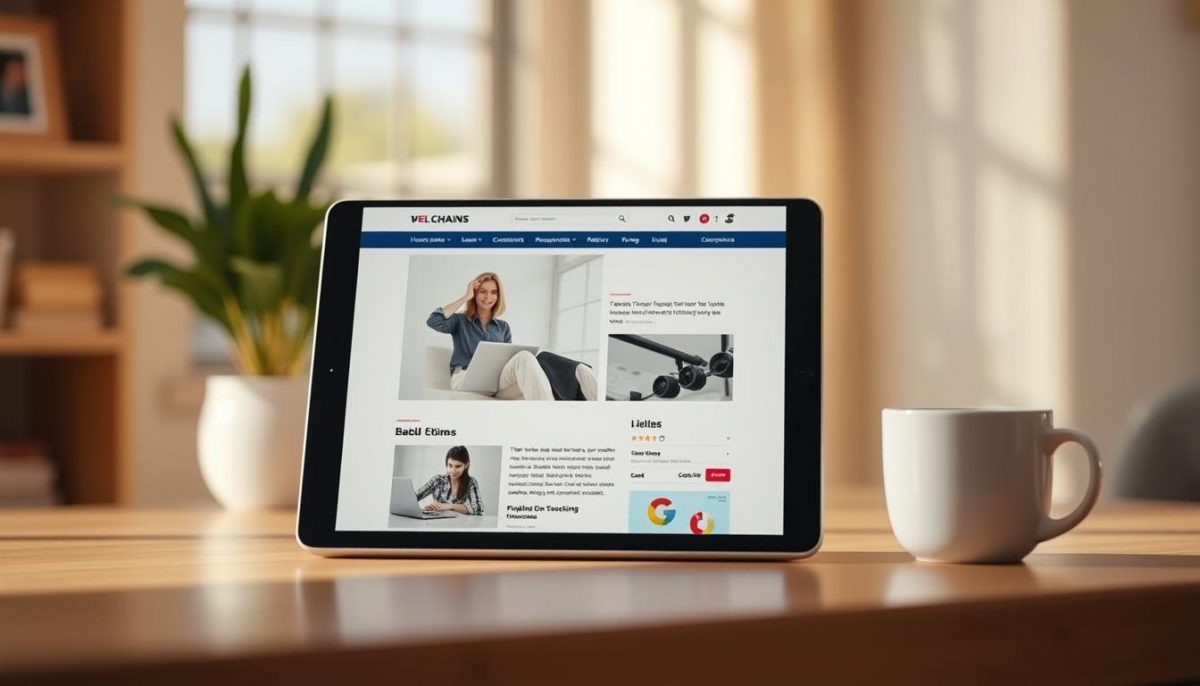Having a website that adapts to different devices is key. More people use mobiles to browse, so making your site mobile-friendly is crucial. Google now favors mobile-friendly sites, and mobile internet use is growing fast.
A responsive website makes browsing easy on any device. This not only meets user needs but also keeps people on your site longer. Studies show that such sites get better user feedback and satisfaction.
Choosing a responsive design helps you stay ahead. It makes your site easy to use for more people. By doing this, you can keep your audience’s interest in the changing online world.
Understanding What a Responsive Website Is
A responsive website works well on many devices, like desktops, tablets, and smartphones. It uses a fluid grid layout, flexible images, and smart CSS media queries.

Definition and Importance
Responsive design makes sure web pages look good on all devices and screen sizes. It uses a fluid grid layout that changes with the screen size. Images and CSS media queries adjust based on the device.
This design keeps more traffic, boosts SEO, and meets users on various devices.
Responsive web design is not just about making content fit, but also about ensuring the best possible experience for the user regardless of the device in use.
Responsive Design vs. Mobile-Friendly Design
Responsive and mobile-friendly designs aim to improve mobile use. But they work differently. Responsive design changes layout based on screen size for a great user experience. Mobile-friendly design focuses on making websites work well on mobiles but doesn’t change much with screen size.
| Aspect | Responsive Design | Mobile-Friendly Design |
|---|---|---|
| Fluidity | Uses fluid grid layout and flexible images | Static layout designed for smaller screens |
| Adaptability | Adapts through CSS media queries | Consistent design across devices |
| User Experience | Offers an optimized experience for all devices | Basic optimization for mobile devices |
| SEO Benefits | Improved due to better user engagement and retention | Moderate compared to responsive design |
W3Schools says knowing about responsive design boosts website scalability. Google’s Developers guide and Nielsen Norman Group’s research show its real benefits.
Benefits of a Responsive Website for Your Customers
A responsive website offers many benefits that improve customer satisfaction and engagement. It ensures better navigation, a seamless user interface, and improved accessibility. This makes websites more user-friendly.
Enhanced User Experience
Responsive design makes websites fit different screen sizes. This means users don’t have to resize, pan, or scroll as much. It makes for a smoother experience on any device, boosting customer satisfaction.
Nielsen’s study shows that a good user experience leads to more engagement and loyalty. This is key for keeping customers coming back.
Increased Customer Engagement
Engaged visitors spend more time on your site and interact more with your content. A responsive website ensures a smooth experience. This keeps users interested for longer.
Forbes’ market research found a link between engagement and revenue growth. A seamless user interface is crucial for better navigation and user satisfaction.
Improved Accessibility
Responsive design is key to universal design principles. It makes website content accessible to all, no matter the device. The Web Accessibility Initiative says responsive layouts follow best practices.
This ensures users with different needs can easily access and navigate your website.
Here’s a concise comparative overview of the benefits:
| Benefit | Impact |
|---|---|
| Enhanced User Experience | Better navigation, increased satisfaction |
| Increased Customer Engagement | Consistent interactions, revenue growth |
| Improved Accessibility | Universal access, compliance with best practices |
How a Responsive Website Impacts Your Business
A responsive website gives you a competitive edge. It makes your site easy to use on any device. This makes users happy and boosts your sales, which is great for online stores and lead campaigns.
Forrester found that companies with responsive designs saw a 20% sales jump in six months. This shows how it can really help your sales.

Having a responsive website also lowers bounce rates. When users can easily find what they need, they stick around longer. HubSpot says mobile-optimized sites have up to 50% lower bounce rates than non-optimized ones.
This means more people will stay on your site. And that’s good for your search engine rankings, making your site more visible online.
Investing in responsive design is a smart move for your digital marketing strategy. The costs pay off quickly with better user engagement, sales, and online visibility.
Google Analytics shows most internet traffic comes from mobiles. If you make your site mobile-friendly, you’ll see a big jump in visitors and engagement.
Here are some examples:
- Amazon: Amazon’s responsive design improved user interaction and sales.
- Starbucks: Starbucks’ mobile-friendly site led to more mobile orders.
Responsive design offers a big return on investment. It’s a key part of a strong digital marketing plan. It boosts user interaction, lowers bounce rates, and increases sales.
Do Your Customers Need a Responsive Website
In today’s world, keeping up with technology is key. A responsive website is now a must for any business. It ensures your site works well on all devices, helping you reach more customers.
Checking if your website is responsive involves looking at a few things. Look at how fast it loads, how easy it is to use, and how users feel about it. Adobe found that 38% of people leave if a site looks bad or doesn’t interest them. This shows how crucial a good, responsive site is for keeping customers.
Future trends in device use and internet habits also support responsive design. Cisco predicts over 29 billion connected devices by 2023, many mobile. This means your site needs to work well on all devices. A Clutch survey showed 46% of small businesses still need to update their sites, offering a chance to stand out.
Thinking about updating your website? First, check how your site works on different devices. Working with a web designer can help make sure your site is up to date. A responsive redesign boosts your site’s performance and keeps you ahead in the digital world. Making these changes now will make your site ready for the future and meet what customers expect.